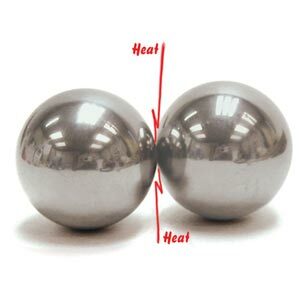July 10, 2010
 by Ted Beyer
by Ted Beyer
One of my favorite authors, Arthur C. Clark, once said, “Any sufficiently advanced technology is indistinguishable from magic.” This has been quoted, misquoted and reused for years. Of course, it’s perfectly true, and magicians have been using science as part of their acts for centuries. Things that we take for granted today were once bleeding edge technology. I remember in high school reading that sometime ‘soon’ (this was more than 30 years ago) there would be TVs that would be so thin that they would hang on the wall like pictures – impossible! A generation before, the concept of television itself was astonishing, and a generation before that, moving pictures of any kind were magical.
As I started to think about this, I suddenly realized that there are many products that we sell here at Educational Innovations that are used – currently – by magicians as ‘tricks’ in their act. Let’s take a look…. Read the rest of this entry »
 Leave a Comment » |
Leave a Comment » |  Chemistry, College level, Elementary level, experiments, High School level, Middle School level, Physics | Tagged: discrepant event, eddy currents, ice melting blocks, Lenz's Law, magic, magic snow, Newton's Nightmare, nitinol wire, PBL, phenomenon based learning, slush powder, snow polymer, sodium polyacrylate |
Chemistry, College level, Elementary level, experiments, High School level, Middle School level, Physics | Tagged: discrepant event, eddy currents, ice melting blocks, Lenz's Law, magic, magic snow, Newton's Nightmare, nitinol wire, PBL, phenomenon based learning, slush powder, snow polymer, sodium polyacrylate |  Permalink
Permalink
 Posted by Tami O'Connor
Posted by Tami O'Connor
July 9, 2010
 by: Martin Sagendorf
by: Martin Sagendorf
On a Bright Day:
A great deal of energy falls on the Earth’s surface – roughly 1 kW per square meter. This is about 0.6 Watt per square inch. This doesn’t sound like much energy, but suppose we collect and concentrate 63 square inches of this sunlight? These 63 square inches would collect about 38 Watts of energy. This doesn’t sound like much, but…
Suppose We Could Then:
Concentrate these 38 Watts into an area of only 1/8 of a square inch? This is exactly what we can do with an inexpensive plastic Fresnel lens. We’ll focus the sunlight into an area 3/8” in diameter – this is the equivalent of 300 Watts per square inch! With this energy level, we can easily ignite a piece of wood, boil some water, and even melt a penny.
A Suitable Device:
Is described in the book, Physics Demonstration Apparatus and in the blog The Sun’s Energy.
Now we’re going to describe how to build a much simpler version that works just as well – one that uses a very inexpensive Fresnel lens and is very easy to construct. Read the rest of this entry »
 7 Comments |
7 Comments |  College level, energy, experiments, High School level, Physics | Tagged: atomic penny vaporizer, awesome experiment, Fresnel lens, melting pennies, physics demonstration apparatus, solar energy |
College level, energy, experiments, High School level, Physics | Tagged: atomic penny vaporizer, awesome experiment, Fresnel lens, melting pennies, physics demonstration apparatus, solar energy |  Permalink
Permalink
 Posted by Tami O'Connor
Posted by Tami O'Connor
June 13, 2010
 by: Tami O’Connor
by: Tami O’Connor
When two 1-pound, 2-inch diameter, chrome steel spheres are smashed together, enough heat is generated at the point of contact to burn a hole in ordinary paper! This dramatic demonstration has been a favorite of students in every grade for as long as I have been teaching!
 There are a few considerations when allowing students (especially younger ones) to conduct this activity on their own… First, the spheres are pretty heavy, so if they were either dropped on a foot or onto a nice tile floor, the result would not be good. Also, be sure that the only thing between the spheres is paper or aluminum foil. Fingers caught between the colliding spheres would not be happy. Finally, all participants should wear safety glasses, as it is not unusual for a small piece of paper to fly off after the spheres collide.
There are a few considerations when allowing students (especially younger ones) to conduct this activity on their own… First, the spheres are pretty heavy, so if they were either dropped on a foot or onto a nice tile floor, the result would not be good. Also, be sure that the only thing between the spheres is paper or aluminum foil. Fingers caught between the colliding spheres would not be happy. Finally, all participants should wear safety glasses, as it is not unusual for a small piece of paper to fly off after the spheres collide.
Read the rest of this entry »
 2 Comments |
2 Comments |  College level, Elementary level, energy, experiments, High School level, Middle School level, Physics | Tagged: awesome science experiment, discrepant event, F=MA, kinetic energy, PBL, phenomenon based learning, shock waves, smashing steel spheres, thermal energy, thermite reactions |
College level, Elementary level, energy, experiments, High School level, Middle School level, Physics | Tagged: awesome science experiment, discrepant event, F=MA, kinetic energy, PBL, phenomenon based learning, shock waves, smashing steel spheres, thermal energy, thermite reactions |  Permalink
Permalink
 Posted by Tami O'Connor
Posted by Tami O'Connor
June 12, 2010
 by: Martin Sagendorf
by: Martin Sagendorf
This 3D Magnetic Field demonstration is actually quite easy to do. It clearly illustrates that magnetic fields are not flat (as too frequently demonstrated in the classroom).
Demonstrating a 3D Magnetic Field
This easy-to-make construction requires only four components:
- A clear plastic bottle (about 1-3/4” in one dimension) – the one illustrated below is a 12.6 fl oz ultra concentrated Joy ® dishwashing soap bottle – Note that any bottle originally containing soap or detergent will require repeated rinses to completely remove all of its original contents.

- Six 17 mm x 3 mm Neodymium ring magnets Read the rest of this entry »
 Leave a Comment » |
Leave a Comment » |  Elementary level, experiments, magnetism, Middle School level, Physics | Tagged: fun experiments, magnetic fields, magnets, phenomenon based learning |
Elementary level, experiments, magnetism, Middle School level, Physics | Tagged: fun experiments, magnetic fields, magnets, phenomenon based learning |  Permalink
Permalink
 Posted by Tami O'Connor
Posted by Tami O'Connor
June 1, 2010
 by: Martin Sagendorf
by: Martin Sagendorf
We recognize heat & cold, dry & damp, light & dark, and sound & silence. However… I find it absolutely fascinating to consider that we also live within something that we can’t see, hear, touch, or taste.
We all Know:
Our planet has a giant magnet near its core and that its field extends over the whole of the Earth’s surface. But, do we ever really think about this field that passes through soil, rocks, buildings… and us? Granted, relatively speaking this ‘field’ isn’t particularly strong. In fact, it’s a rather weak field when compared to those of a horseshoe magnet or, particularly, a modern Rare Earth magnet.
A Great Demo to show Earth’s Magnetic Field:
Read the rest of this entry »
 Leave a Comment » |
Leave a Comment » |  Earth Science, Elementary level, experiments, High School level, magnetism, Middle School level, Physics | Tagged: compass, Earth's magnetic field, magnetism, neodymium magnet, simple classroom activity |
Earth Science, Elementary level, experiments, High School level, magnetism, Middle School level, Physics | Tagged: compass, Earth's magnetic field, magnetism, neodymium magnet, simple classroom activity |  Permalink
Permalink
 Posted by Tami O'Connor
Posted by Tami O'Connor




 Posted by Tami O'Connor
Posted by Tami O'Connor  by: Martin Sagendorf
by: Martin Sagendorf by: Tami O’Connor
by: Tami O’Connor
